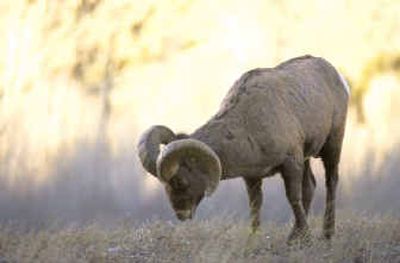Yellowstone ideal for winter wildlife watchers

CODY, Wyo. – Wildlife watching outside Yellowstone National Park’s East Gate isn’t exactly like an African safari.
The weather is slightly different. During one recent week, it will hit 96 degrees in Kenya; the mercury will strain to reach 30 in Cody. Gone are the shutterbugs hanging out of open Jeeps; faint-hearted photographers may prefer to crank up the heat, rolling down the windows only far enough to periscope their cameras out the cracks.
Despite such differences, wildlife watchers can still see plenty of critters by taking a winter safari. Highway 14-16-20 – the road that leads from Cody to Yellowstone along the North Fork of the Shoshone River – is one of several prime viewing locations.
Along the Shoshone, bighorn sheep appear content at impossible angles on sheer cliffs. Brown- and buff-colored herds of elk hang out in snow-covered hayfields. Mule deer line the road.
But these “winter rangers” down from their higher perches are just the most obvious, according to Lynette Otto, Shoshone National Forest wildlife biologist.
“Many people know about the opportunities to watch animals such as bighorn sheep, mule deer and elk on their winter ranges,” Otto said. “But there are other wildlife species that also are exciting to watch.”
Like eagles. Both bald and golden eagles depend on animal carcasses during the winter and spend a lot of time scavenging road kill, often perching nearby in dead trees and power poles. They are also more likely to dine together as they are less territorial this time of year, Otto said.
The American dipper, or water ouzel, can be seen taking a polar plunge into the Shoshone’s frigid, fast water on its year-round insect quest. Beavers are often swimming around and otters may be seen sliding on the snow and ice beside the stream.
Bison from the park also show up along the roadside. They have an unusual way of clearing snow to reach the grass underneath, by swinging their massive heads from side to side.
Visitors brave enough to venture outside their car will find an entire storybook written in the winter tracks that crosshatch the forest.
“Learning to identify tracks of different wildlife species is great fun and can give you more understanding of the animals’ behavior because you can see where they’ve been and where they’re going,” Otto said. “Common tracks to see in and around forested areas are red squirrels, rabbits, martens and weasels.”
Seldom-seen bobcats, coyotes and wolves also make tracks when they round up the food needed to survive the cold months, Otto said.
Unless you’re planning to trek around (or get stuck in a ditch), outfitting your winter safari vehicle won’t take much. Binoculars, boots and a camera with a telephoto lens should do it.
Don’t molest the animals. They’re stressed enough in winter. Be quiet and try not to distract the animal from whatever it is doing. And when following tracks, do not disturb or dig in any crevices or holes – you might expose the animal to predators or inadvertently destroy a food cache.
“It’s even more important not to stress the animals by getting too close or chasing them,” Otto said. “When they are stressed, they use more energy. Food is scarce in the winter, and stressed animals may not be able to find enough food to restore their reserves. This makes them more vulnerable to starvation or disease in a harsh winter.”
Oh, and watch the road, too. While wild animals may be more interesting than yellow lines, the number of animals and animal watchers might call for quick stops. Icy roads can be a problem.
Barring that, have fun learning about these denizens of the woods and how they live through the Wyoming winter, Otto said. It’s not Kenya, but it’s worth the drive.